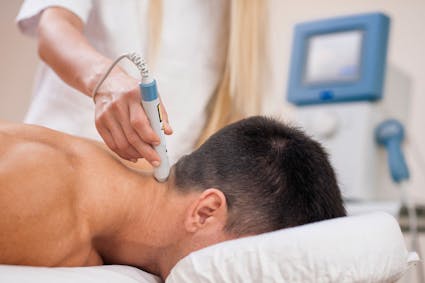
LASER Therapy is also known as photobiomodulation. It entails the use of specific wavelengths of light (red and near infrared) to generate a photochemical response in damaged or dysfunctional tissue.
The LASER works by creating an increase of vasodilatation (blood supply), bringing in oxygen to the cells. It stimulates the lymphatic system, pulling edema and inflammation from the area. ATP (Adenosine triphosphate) production is stimulated in the cells helping them have the energy to function normally. The pain reflex is broken, offering immediate relief of pain.
LASER therapy can alleviate pain, reduce inflammation and accelerate recovery from a wide range of acute and chronic clinical conditions. Significant reduction in edema (swelling) has been noted as well as tissues are better able to move fluids out through lymphatic drainage pathways.
Cleared by the FDA in 2003, Class IV LASER therapy has become standard of care for many musculoskeletal injuries. Class IV LASERs can penetrate over 4 inches into the deep musculoskeletal tissue. The number of treatments required depends on the nature of the problem and the length of time the patient has been affected by it. Some conditions may be resolved with as few as one treatment. However, chronic and/or deep-seated conditions may take as many as 10 treatments.
LASER therapy technology has been recently endorsed by professional organizations such as the American Physical Therapy Association (APTA), World Health Organization (WHO) and International Association for the Study of Pain (IASP). There are no known side effects from LASER therapy and the results are long lasting.
LASER Therapy has been proven to be effective for a wide variety of conditions. Some of them include:
Soft Tissue Injuries
- Tendinitis
- Back and Neck Pain
- Carpal Tunnel Syndrome
- Myofascical Trigger Points
- Epicondylitis (Tennis Elbow)
- Sprains, Strains
- Repetitive Strain Injuries
- Chondromalacia Patellae
- Plantar Fascitis
Degenerative Joint Conditions
- Rheumatoid Arthritis (RA)
- Osteoarthritis (OA)
- Neurogenic Pain
- Herpes Zoster (Shingles)
- Post-traumatic Injury
- Trigeminal Neuralgia
- Fibromyalgia
- Diabetic Neuropathy
- Chronic Non-Healing Wounds
- Diabetic Foot Ulcers
- Burns
Is the laser FDA approved?
Yes, the laser was first approved on Feb. 11, 2002 for the treatment & management of Carpal Tunnel Syndrome.Does LASER therapy really work?
- Yes, research has demonstrated that:
- Injuries treated with LASER therapy heal faster
- LASER Therapy has a strengthening effect on tissue repair
- LASER Therapy improves blood flow & lymphatic drainage
- It is an effective means of relief for many pain syndromes
- It can improve immune response
How does the LASER treatment work?
Treatment for pain is performed by the physical therapist by placing the LASER in contact with the skin allowing the photon energy to penetrate tissue, where it interacts with various intracellular bio molecules resulting in the restoration of normal cell function. This enhances and essentially speeds the body's natural healing processes.
The treatment process results in a disappearance of symptoms. Additionally, the immune system response is stimulated, Lymphatic drainage is improved, production of growth hormone is increased, and the body's natural healing processes are enhanced and essentially sped up.
How long is each treatment?
Treatments last between 5 and 15 minutes depending on your injury and the body part being treated.
How many treatments are required before I see results?
Results are often experienced on the first treatment though often takes 5 to 10 treatments to completely relieve the problem
